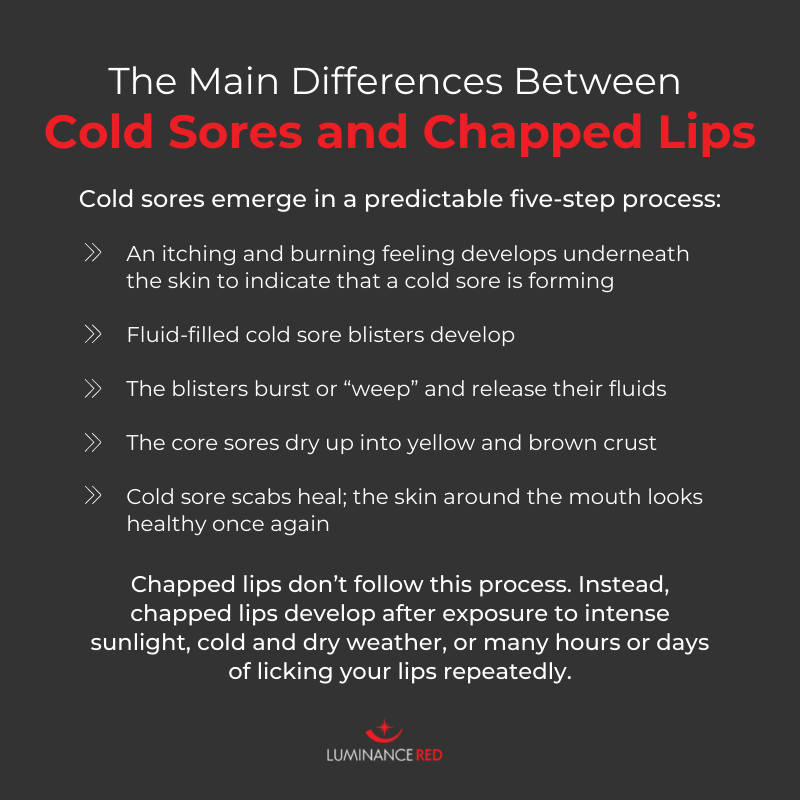How Can You Tell the Difference Between Cold Sores and Cracked Lips?

Whether it’s a blustery winter day or the summer sun is beating down relentlessly, your lips are at risk of cracking, chapping, and blistering. Should you blame a cold sore or chapped lip for your pain and discomfort?
It’s important to learn how to differentiate between cold sores and chapped lips so that you can get the treatment you need and avoid spreading the herpes virus to others.
Why Are Cold Sores and Chapped Lips Often Confused?
Cold sores and chapped, cracked lips often present similar symptoms, especially if they’re the result of extreme weather. This commonly leads people to falsely treat cold sores as chapped lips, or chapped lips as cold sores. Unfortunately, when used incorrectly, these treatments can exacerbate the problem further.
How Does Sunlight Cause Cold Sores?
The ultraviolet (UV) radiation emitted, especially from the midday sun, is a scientifically—is a scientifically documented trigger for outbreaks of the herpes simplex virus. Studies show that UV light has a significant effect on the skin’s immune activity. Sunburn is the most familiar example of the inflammatory consequences of sun exposure to the skin.
When the skin around your mouth is exposed to the sun, its UV radiation triggers viral activity within the body. This draws the herpes virus out of dormancy and often leads to an unwanted, unexpected cold sore outbreak.
One study from the Kobe University Graduate School of Medicine found that the number of people who reported herpes outbreaks nearly doubled during the summer months, from 10.4 percent of participants to 19.7 percent. Another scientific study found that the use of sunscreen achieved more than 95% suppression of oral herpes recurrences compared to the use of a placebo.
How Does Extreme Weather Cause Chapped Lips?
Unlike other parts of the skin, your lips don’t contain oil glands, so they quickly become dry and dehydrated when exposed to the sun or intense cold.
It’s easy enough to alleviate chapped lips with chapstick and hydration, but severely chapped lips can become infected and trigger painful symptoms that may be mistaken for the herpes virus:
- -Weeping ulcers
- -White plaques on the surface
- -Lumpy texture
- -Dark pink and red color
The Main Differences Between Cold Sores and Chapped Lips
Cold sores and chapped lips develop differently. If you know what to look for, it’s relatively easy to tell the difference between these two conditions.
Cold sores emerge in a predictable five-step process:
- An itching and burning feeling develops underneath the skin to indicate that a cold sore is forming
- Fluid-filled cold sore blisters develop
- The blisters burst or “weep” and release their fluids
- The core sores dry up into a yellow and brown crust
- Cold sore scabs heal; the skin around the mouth looks healthy once again
Chapped lips don’t follow this process. Instead, chapped lips develop after exposure to intense sunlight, cold and dry weather, or many hours or days of licking your lips repeatedly. The most common chapped lips symptoms include dryness, flaking, scales, and cracks on the entire surface of the top and bottom lips.
Cold sores, on the other hand, develop into defined sores and ulcers on or around the mouth area. They rarely impact the entire surface of the top and bottom lips.

How to Manage Chapped Lips
Here’s the good news: chapped lips are easy to manage! First, avoid the risk factors for chapped lips, such as:
- -Harsh weather conditions
- -Poor hydration
- -Excessive smoking
- -Vitamin B2 deficiency
- -Kissing someone with a bacterial or fungal infection
Then tackle actively chapped lips with these simple steps:
- Drink plenty of water to keep your body and skin hydrated
- Apply chapstick at least two to three times per day
- Use aloe vera or coconut oil to supplement the chapstick if desired
If your chapped lips symptoms don’t improve in a few days, consider contacting your doctor to be evaluated for a potential skin infection.
How to Manage a Cold Sore
What can you do to heal your cold sore? Try these techniques and strategies to escape the misery and pain of cold sore blisters.
Over-the-Counter and Prescription Options
Orajel™ is an over-the-counter topical gel that provides instant and targeted pain relief in and around the mouth. The Orajel™ Cold Sore formula includes six active ingredients shown to treat the pain, itching, and dryness caused by cold sores.
Abreva® is another over-the-counter cream used to treat cold sores and fever blisters, but it works differently. Abreva® contains the only non-prescription ingredient approved by the Food and Drug Administration (FDA) to accelerate the cold sore healing process. This Over the counter (OTC) treatment can be used up to five times a day, or as directed by your doctor.
When over-the-counter strength isn't enough, consider an antiviral prescription. It’s available in tablet, capsule, or liquid form to decrease the pain and increase the healing time of sores and blisters caused by genital herpes and cold sores. This antiviral medication stops the spread of the herpes virus in the body, which in turn helps outbreaks heal.
The Luminance RED Light Therapy
What if you could minimize the symptoms of cold sores and prevent them in the future, all without a visit to the drugstore? The Luminance RED cold sore treatment makes this easier than ever before!
The light from Luminance RED is metabolized by your skin and turned into cellular energy, which your skin uses to heal faster and force the herpes virus into hibernation. Clinical data conclusively shows that this type of treatment reduces healing time by up to 50% so that you can get back to living your life.
The Luminance RED can be used before, during, and after outbreaks to fight symptoms of Herpes Simplex Virus (HSV 1 & 2). Thanks to the precise design of Luminance RED, every treatment provides the exact wavelength of light necessary to maximize treatment efficiency and prevent cold sore outbreaks.

















